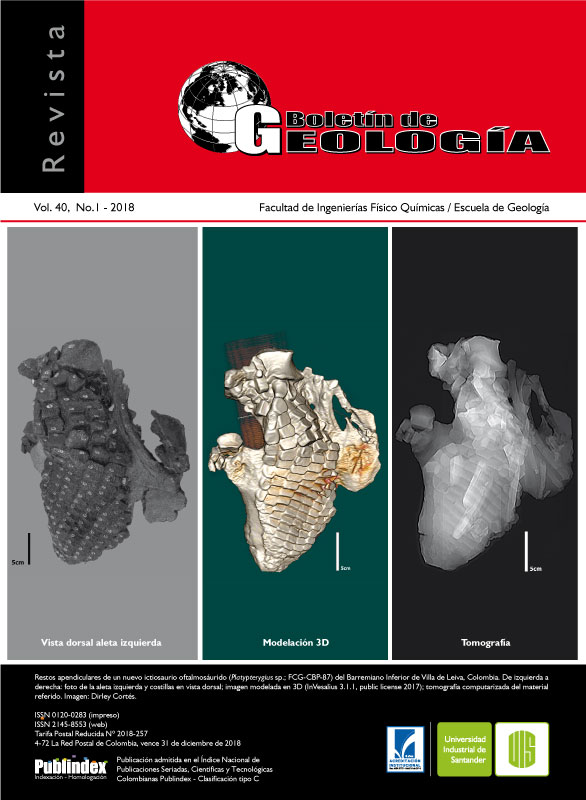Preliminary geochemical study of thermal waters at the Puracé volcano system (South Western Colombia): an approximation for geothermal exploration
Published 2018-02-23
Keywords
- Puracé volcano,
- Hot Springs,
- Hydrogeochemistry,
- Geothermometers,
- High enthalpy system
How to Cite
Altmetrics
Abstract
The Puracé Volcano is located in the Cauca department, SW of Colombia, along the Coconucos volcanic chain. This volcano is an interesting target for geothermal exploration, because it is a young caldera-type volcano, with thermal activity (e.g. hot springs and fumaroles). Using hydro-geochemical analyses of hot springs, we determine the type of water, origin and relation with the geothermal system, reservoir temperature, mixing process and finally the potential areas for future exploration. The analyzed water-types are bicarbonate, dilutechloride, sulphate-chloride, acid-sulphate and heated steam-acid sulfated. The conservative elements, allow to identify the correlation between different springs and to infer commune sources. Moreover, the applied solutes geothermometers for each suitable thermal-water group were used to estimate the reservoir temperature. The Silica geothermometers resulted within a range of 120°C -170°C while those the Cation geothermometers are above these temperatures reflecting values from 160°C to 220°C. However, the Cation geothermometer of low temperature clearly identify another zone of lower temperature. Mixing and recharge processes, were identified through of stable isotopes. Finally, the preliminary geothermal model shows two zones of high enthalpy system (>150°C).
Downloads
References
Arnórsson, S., and Gunnlaugsson, E. (1985). New gas geothermometers for geothermal exploration-calibration and application. Geochimica et Cosmochimica Acta, 49(6), 1307-1325. doi: 10.1016/0016-7037(85)90283-2.
Bohorquez, O.P., Monsalve, M.L., Velandia, F., Gil, F., y Mora, H. (2005). Marco tectónico de la cadena volcánica más septentrional de la cordillera central de Colombia: Boletín de Geología, 27(44), 55-79.
Burgos, M. (1999). Geochemical interpretation of thermal fluid discharge from wells and springs in Berlín geothermal field, El Salvador. Geothermal Training Programme, Report Number 7, Reykjavík, Iceland.
Chandrasekharam, D., and Bundschuh, J. (2008). Low-enthalpy geothermal resources for power generation. Leiden: CRC Press/Balkema.
Ellis, A.J., and Mahon, W.A.J. (1977). Chemistry and geothermal systems. New York: Academic Press INC.
Fournier, R.O. (1979). A revised equation for the Na/K geothermometer. Geothermal Resources Council Transactions, 5, 1-16.
Fournier, R.O. (1981). Application of water geochemistry to geothermal exploration and reservoir engineering. In L. Ryback, and L.J.P. Muffler (Eds.), Geothermal systems: Principles and case histories (pp. 109-143). Chichester: John Wiley and Sons.
Fournier, R.O., and Potter, R.W. (1982). A revised and expanded Silica (Quartz) geothermometer. Geothermal Resources Council Bulletin, 11(10), 3-12.
Fournier, R.O., and Truesdell, A. (1973). An empirical Na–K–Ca geothermometers for natural waters. Geochimica et Cosmochimica Acta, 37(5), 1255-1275. doi: 10.1016/0016-7037(73)90060-4.
Garzón, G., Salazar, S.P., Serna, D.Y., Bobadilla, L., Lesmes, L.E., Diago, J.C., and Mojica, J. (2004). Thermal springs of Colombia active volcanoes. 11th International Symposium on Water-Rock Interaction, Londres.
Giggenbach, W.F. (1988). Geothermal solute equilibria. Derivation of Na-K-Mg-Ca geoindicators. Geochimica et Cosmochimica Acta, 52(12), 2749-2765. doi: 10.1016/0016-7037(88)90143-3.
Giggenbach, W.F. (1991). Chemical techniques in geothermal exploration. In: F. D’Amore (Ed.), Applications of geochemistry in geothermal reservoir development (pp. 119-144). Roma: UNITAR.
Giggenbach, W.F. (1992). Isotopic shifts in waters from geothermal and volcanic systems along convergent plate boundaries and their origin. Earth and Planetary Science Letters, 113(4), 495-510. doi: 10.1016/0012-821X(92)90127-H.
Giggenbach, W.F. (1993). Redox control of gas compositions in Phillippine volcanic hydrothermal systems. Geothermics, 22(5-6), 575-587. doi: 10.1016/0375-6505(93)90037-N.
Giggenbach, W.F., and Goguel, R.L. (1989). Collection and analysis of geothermal and volcanic water and gas discharges. 4th Ed. Report No. CD 2401. Pentone: Department of Scientific and Industrial Research.
Karingithi, C.W. (2009). Chemical geothermometers for geothermal exploration. Short Course IV on Exploration for Geothermal Resources, organized by UNU-GTP, KenGen and GDC, at Lake Naivasha, Kenya, 1-22.
Marquínez, G., Rodríguez, Y., Terraza, R., y Martínez M. (2003). Geología de la plancha 365 Coconucos, escala 1:100.000. INGEOMINAS.
Maya, M. y González, H. (1995). Unidades litodémicas en la Cordillera Central de Colombia. Boletín geológico INGEOMINAS, 35, 43-53.
Monsalve, M.L. (2000). Catálogo de las volcanitas Neógenas de Colombia, Fascículo Formación Coconucos. INGEOMINAS, 32 p.
Nicholson, K. (1993). Geothermal fluids: Chemistry and exploration techniques. Berlin: Springer.
Nuti, S. (1991). Isotopic techniques in geothermal studies. In: F. D’Amore (Ed.) Applications of geochemistry in geothermal reservoir development (pp. 215-250). Rome, Italy: UNITAR/UNDP Centre on Small Energy Resources.
O’Brien, J. (2010). Hydrogeochemical characterization of the Ngatamariki geothermal field and a comparison with the Orakei Korako thermal area, Taupo Volcanic Zone, New Zealand. M.Sc. Thesis. University of Canterbury. New Zealand.
Powell, T., and Cumming, W. (2010). Spreadsheets for geothermal water and gas geochemistry. Proceedings of 35th Workshop on Geothermal Reservoir Engineering. Stanford University, California.
Servicio Geológico Colombiano. (2012). INVTERMALES. Inventario Nacional de Manifestaciones Hidrotermales. Consultado el 20 de febrero de 2017. http://hidrotermales.sgc.gov.co/.
Torres, M.P., Monsalve, M.L., Pulgarín, B., y Cepeda, H. (1999). Caldera de Paletará: Aproximación a la fuente de las ignimbritas del Cauca y Huila. Boletín Geológico de INGEOMINAS, 37, 1-15.
Tonani, F. (1980). Some remarks on the application of geochemical techniques in geothermal exploration. Proceedings, Advances in European Geothermal Research, 2nd Symposium. Strasbourg, France.
Truesdell, A. (1976). Summery of section III: Geochemical techniques in exploration. Proceedings 2nd United Nations Symposium on the Development and Use of Geothermal Resources. San Francisco, USA.

